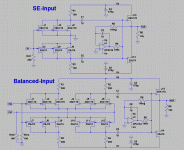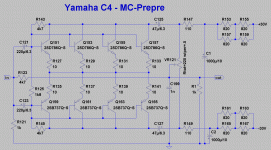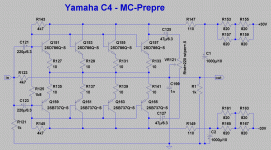Hi,
two mods of the circuit from #1.
The SE-Input as described in #19.
The drain resistors roughly halved in value to achieve the same gain figures.
Noise is slightly lower than #1 and output phase is reversed.
THD is indeed a bit higher, but still at a perfectly negligable level.
Not bad for six (matched) JFETs and two resistors less
As said before, the differential input is good to combine two signals.
So instead of feeding the differential input with a SE-signal, why not feed it balanced and profit from the noise immunity of a balanced connection?
The Balanced-Input achieves the same figures regarding noise and gain as #1.
The THD is by a jota lower due to each input seeing just half of the input signal.
If overhead would be a problem the balanced input would be advantageous here also.
Only difference to circuit #1 is the split input loading resistor Rin and its connection.
rem. the nomencalatura of the parts matches that of #1 for easy comparison
jauu
Calvin
two mods of the circuit from #1.
The SE-Input as described in #19.
The drain resistors roughly halved in value to achieve the same gain figures.
Noise is slightly lower than #1 and output phase is reversed.
THD is indeed a bit higher, but still at a perfectly negligable level.
Not bad for six (matched) JFETs and two resistors less
As said before, the differential input is good to combine two signals.
So instead of feeding the differential input with a SE-signal, why not feed it balanced and profit from the noise immunity of a balanced connection?
The Balanced-Input achieves the same figures regarding noise and gain as #1.
The THD is by a jota lower due to each input seeing just half of the input signal.
If overhead would be a problem the balanced input would be advantageous here also.
Only difference to circuit #1 is the split input loading resistor Rin and its connection.
rem. the nomencalatura of the parts matches that of #1 for easy comparison
jauu
Calvin
Attachments
Last edited:
Rod
Some clarification on your 2SK389 shunt cascode: is that 7mA per fet or for the pair and similarly 11 ohms per source or for the pair?
Hi - this is a different schematic to the one is post 1.
I mention it to illustrate that the 2SK369 (now deleted, sadly) can act as first stage for MC (Lyra Lydian Beta in this case) and give good noise performance.
The K369 in my circuit is a single SE part, cascoded, running about 8V and 7mA. I found that the performance is just as good with GR (green) K369s running 5mA at Idss (Rs = 0).
I hope that a semiconductor maker takes up these large-geometry JFET designs again soon.
I hope that a semiconductor maker takes up these large-geometry JFET designs again soon.
IIRC the quantities required to make this happen would be in the vicinity of 100,000 pieces per month per device type.
Jonathan, while we have your attention, would you say something about acceptable levels of dc and transient current allowed to flow in a high quality MC cartridge?
With JFET (operated at low voltage, to minimise Igss) will the gate currents be low enough to avoid the need to fluxbust?
Thanks!
With JFET (operated at low voltage, to minimise Igss) will the gate currents be low enough to avoid the need to fluxbust?
Thanks!
Hi Rod: Depends somewhat on whether the phono stage designer prioritizes speed or noise. Higher VDS will reduce device capacitances at the cost of higher noise and gate leakage currents, while lower vds will be the opposite. Even when a complementary topology is used, gate leakage currents for Ns increase at a faster rate (vs. vds) than Ps, so input bias cancellation effects will be less effective as the vds increases.
Note that the designer's preference for certain ranges of input resistances will play a role in determining how much vds he uses. The higher the input resistor value is, the more priority the designer will place on reducing gate leakage currents (otherwise DC offset is likely to be high enough to be a nuisance).
Additional problems occur when the phono stage is being powered on or off. The positive rail and negative rail may be out of sync, regulators will still be sorting themselves out, part of the amplification circuit may come up to operating voltage prior to other parts of the circuit, and all of this usually results in a fair amount of DC offset. Most of this will be from the output, but the input can also be affected.
But note that the act of cuing the MC cartridge onto the LP will also bias the coil former in an undesirable manner. A permeable coil former is always attracted to the magnetic circuit; normally the undulating LP groove makes the motion reciprocating (and therefore AC). During the cue-on action, however, the coil former is subjected to an upward, unidirectional force which takes time to recover from, and this will magnetize the former by a little bit.
How much does this actually matter? MC cartridges seem to play OK with bipolar input phono stages (which would have far greater input bias currents than JFETs), also after being cued onto LPs hundreds of time, so regarding functionality (for example a loss of tracking ability), I doubt if you would be able to quantify much. Subjectively, however, many listeners and designers (fluxbusters were first introduced by Luxman, the amplifier manufacturer, and Namiki Jewel, maker of cartridge cantilevers and styli) have spoken up in favor of the effects of fluxbusting. So how much it matters is up to how subjective and fastidious each individual wishes to be.
As to how much current a cartridge coil can withstand, I have a decapitated DL103 which I have been meaning to test how much current the coil wires can take before they pop. The 103 coils use 15um copper wire (at the most), and I would expect it to fry before most other MC cartridges (although the Clearaudios are also known for using thin wire and lots of it). Haven't gotten around to it, yet.
kind regards, jonathan
Note that the designer's preference for certain ranges of input resistances will play a role in determining how much vds he uses. The higher the input resistor value is, the more priority the designer will place on reducing gate leakage currents (otherwise DC offset is likely to be high enough to be a nuisance).
Additional problems occur when the phono stage is being powered on or off. The positive rail and negative rail may be out of sync, regulators will still be sorting themselves out, part of the amplification circuit may come up to operating voltage prior to other parts of the circuit, and all of this usually results in a fair amount of DC offset. Most of this will be from the output, but the input can also be affected.
But note that the act of cuing the MC cartridge onto the LP will also bias the coil former in an undesirable manner. A permeable coil former is always attracted to the magnetic circuit; normally the undulating LP groove makes the motion reciprocating (and therefore AC). During the cue-on action, however, the coil former is subjected to an upward, unidirectional force which takes time to recover from, and this will magnetize the former by a little bit.
How much does this actually matter? MC cartridges seem to play OK with bipolar input phono stages (which would have far greater input bias currents than JFETs), also after being cued onto LPs hundreds of time, so regarding functionality (for example a loss of tracking ability), I doubt if you would be able to quantify much. Subjectively, however, many listeners and designers (fluxbusters were first introduced by Luxman, the amplifier manufacturer, and Namiki Jewel, maker of cartridge cantilevers and styli) have spoken up in favor of the effects of fluxbusting. So how much it matters is up to how subjective and fastidious each individual wishes to be.
As to how much current a cartridge coil can withstand, I have a decapitated DL103 which I have been meaning to test how much current the coil wires can take before they pop. The 103 coils use 15um copper wire (at the most), and I would expect it to fry before most other MC cartridges (although the Clearaudios are also known for using thin wire and lots of it). Haven't gotten around to it, yet.
kind regards, jonathan
Jonathan, thank you - I had not considered the cue-ON events. maybe I need to try a fluxbuster.
The Japanese ultra low-noise BJTs for MC stages (of the 1970s) seemed to vanish soon after the introduction of the Toshiba JFETs - was that down to the base current effect on MC cartridges, I wonder, or improved distortion from the JFETs?
From a highly fastidious MC user's point-of-view, would 1 to 5uA of dc input current have any effect on the performance of the cartridge? Not necessarily from known-measurement criteria, I'm interested also in risks that have not been evaluated yet.
The Japanese ultra low-noise BJTs for MC stages (of the 1970s) seemed to vanish soon after the introduction of the Toshiba JFETs - was that down to the base current effect on MC cartridges, I wonder, or improved distortion from the JFETs?
From a highly fastidious MC user's point-of-view, would 1 to 5uA of dc input current have any effect on the performance of the cartridge? Not necessarily from known-measurement criteria, I'm interested also in risks that have not been evaluated yet.
Hi Rod:
Disconnect the MC cartridge from the phono stage, short the MC cartridge outputs, then play one track of a fairly high-amplitude track. Remove the short, re-connect the MC cartridge, and listen again. If you hear an improvement, probably fluxbusting can make an improvement in your analog setup (although it could be the effects of redoing the electrical connections). If you don't hear any improvement, you can end your experiments in fluxbusting then and there.
AFAIK, low-noise low rbcc BJTs continued to be made throughout the 1990s (Hitachi and Rohm come immediately to mind). Different designers have a fondness for different tools. Seldom does one tool cause the entire market to gravitate away from all other related tools (possible exceptions - ICs vs. discrete circuits, and smd vs. leaded components).
Also, Sony, Yamaha, NEC and other companies made low-noise JFETs that were suitable for use in MC phono front-ends. It is closer to the truth to think of Toshiba as the last player left standing, rather than a player who demonstrated obvious and immediate superiority.
Throughout the latter part of the 1980s and beyond, the market success of the CD shifted development focus away from MC cartridges, which were relegated to an increasingly small nice market. And as the market for MC cartridges dwindled, so did the market for MC phono stages. As I wrote in an earlier post, the quantities needed to make even a medium-sized Japanese semiconductor manufacturer consider introducing or re-introducing a complementary low-noise JFET pair will be in the vicinity of 100,000 pieces per month. While it is conceivable that one company or a consortium of companies could put in an order for a few months of complementary JFET production, it would be a big gamble to sustain such a purchasing effort for more than, say, 6 months.
If you are focused on obviating the need for fluxbusters, uA may be too much. IMO nA, or pA would be better. A designer friend recently introduced an MC phono stage with 1Gohm input loading, which tells you that he must have managed to keep his gate leakage currents very low. OTOH, since there is no way of eliminating cartridge cue-on events, maybe the need for fluxbusters will occur no matter what the phono stage does.
OTOH, if the designer is focused on reducing device capacitances, and the hell with gate leakage currents, that is a valid design approach, too.
IMHO, a single-minded focus on low-noise will result in persuasive-appearing measurements, but not necessarily the best-sounding phono stage.
kind regards, jonathan
maybe I need to try a fluxbuster.
Disconnect the MC cartridge from the phono stage, short the MC cartridge outputs, then play one track of a fairly high-amplitude track. Remove the short, re-connect the MC cartridge, and listen again. If you hear an improvement, probably fluxbusting can make an improvement in your analog setup (although it could be the effects of redoing the electrical connections). If you don't hear any improvement, you can end your experiments in fluxbusting then and there.
The Japanese ultra low-noise BJTs for MC stages (of the 1970s) seemed to vanish soon after the introduction of the Toshiba JFETs - was that down to the base current effect on MC cartridges, I wonder, or improved distortion from the JFETs?
AFAIK, low-noise low rbcc BJTs continued to be made throughout the 1990s (Hitachi and Rohm come immediately to mind). Different designers have a fondness for different tools. Seldom does one tool cause the entire market to gravitate away from all other related tools (possible exceptions - ICs vs. discrete circuits, and smd vs. leaded components).
Also, Sony, Yamaha, NEC and other companies made low-noise JFETs that were suitable for use in MC phono front-ends. It is closer to the truth to think of Toshiba as the last player left standing, rather than a player who demonstrated obvious and immediate superiority.
Throughout the latter part of the 1980s and beyond, the market success of the CD shifted development focus away from MC cartridges, which were relegated to an increasingly small nice market. And as the market for MC cartridges dwindled, so did the market for MC phono stages. As I wrote in an earlier post, the quantities needed to make even a medium-sized Japanese semiconductor manufacturer consider introducing or re-introducing a complementary low-noise JFET pair will be in the vicinity of 100,000 pieces per month. While it is conceivable that one company or a consortium of companies could put in an order for a few months of complementary JFET production, it would be a big gamble to sustain such a purchasing effort for more than, say, 6 months.
From a highly fastidious MC user's point-of-view, would 1 to 5uA of dc input current have any effect on the performance of the cartridge? Not necessarily from known-measurement criteria, I'm interested also in risks that have not been evaluated yet.
If you are focused on obviating the need for fluxbusters, uA may be too much. IMO nA, or pA would be better. A designer friend recently introduced an MC phono stage with 1Gohm input loading, which tells you that he must have managed to keep his gate leakage currents very low. OTOH, since there is no way of eliminating cartridge cue-on events, maybe the need for fluxbusters will occur no matter what the phono stage does.
OTOH, if the designer is focused on reducing device capacitances, and the hell with gate leakage currents, that is a valid design approach, too.
I have found some larger die bipolars to be extremely quiet.
IMHO, a single-minded focus on low-noise will result in persuasive-appearing measurements, but not necessarily the best-sounding phono stage.
kind regards, jonathan
Jonathan, this is something which I'm really interested in. Did you the mentioned test, and if yes, are you willing to share the results?[...]As to how much current a cartridge coil can withstand, I have a decapitated DL103 which I have been meaning to test how much current the coil wires can take before they pop. The 103 coils use 15um copper wire (at the most), and I would expect it to fry before most other MC cartridges (although the Clearaudios are also known for using thin wire and lots of it). Haven't gotten around to it, yet.[...]
Thanks in advance!
- Status
- This old topic is closed. If you want to reopen this topic, contact a moderator using the "Report Post" button.
- Home
- Source & Line
- Analogue Source
- Novel Topology MC pre-preamp


